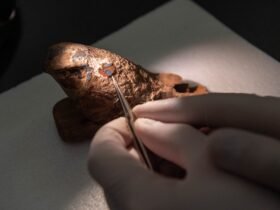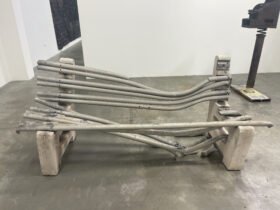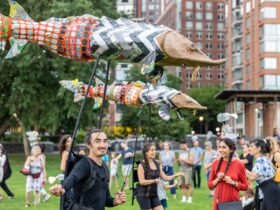When I visited Aubrey Levinthal’s first exhibition in New York in 2020, during the height of the COVID-19 pandemic, I described her as a figurative painter “who seeks to achieve the elusive and disturbing without developing a narrative that is easily can be derived. by the viewer; she is looking for the ambiguous, uncanny and withdrawn as integral features of everyday life.” The current two-person exhibition Lacey Black & Aubrey Levinthal: Daily Nightat Monya Rowe Gallery, confirmed my initial sense of her work as an exploration of formal issues, such as the relationship between figure and ground, to convey the tension between outward appearances and inner states. In her recent work, Levinthal pursues this preoccupation as she ventures into new territory that emphasizes her formal skills, with compelling results.
Levinthal’s collaboration with Black, who is exhibiting for the first time at Monya Rowe, is inspiring, if only because it makes it clear that autobiographical painting can be as much about imagination as it is about observation. Although Black and Levinthal share some formal strategies, such as layering semi-transparent forms, they do so with different goals in mind. Black attempts to transform reality into a magical or dream world, while Levinthal uses formal means to translate inner states into enigmatic outer appearances.

In the middle of the sparsely painted “God on the Metro-North” (2024), Black shows a face looking toward us and another face partially overlapping it and looking away from us. On this last head float a red flower with long stems and the face and hands of a young woman held in prayer, while five teardrop-like shapes descend from the visible eye of the other figure. Is she looking at herself or a ghost? To one side of the heads are two tall, lit candles on an ethereal table; on the other side is an aerial view of a man diving into a pool. Both heads are framed by a soft oval that could be a window or a train on a track. Behind it, at the edge of the painting, are animals, stones and other unexplained objects.
While it is tempting to make up a story for this painting, and that is part of its visual appeal, I think the resistance to the story is more powerful. “God on the Metro-North” doesn’t need to be defined in words to be compelling. The slippery relationship between the incongruent and congruent details is never resolved, leaving us with unanswerable questions.
The same can be said of Levinthal’s apparently simpler paintings. In “Gym Mirror” (2024) the artist explores the suggestive possibilities of foreshortening. A woman in a green tracksuit lies on a surface of black gym mats, her right knee raised and her left leg bent in front of it, like a protective barrier. The hands and legs of the reclining figure are too large; the hand holding the tibia of the right leg is huge and flat, as if it had been passed over with a rolling pin many times. We do not look at the woman, but at her reflection. A small vertical shift between the left and right sides of the hand indicates that the mirror consists of two adjacent parts. A strip of red separates her head from the green of the rest of her outfit. She seems lost in thought. Levinthal has revamped the academic tool of shorthand so that it connects a woman’s state of mind to how she sees herself. She exposes the fear of people going about their daily lives.

One of the most difficult things to depict without a painting turning into familiar tropes is an individual with nothing important around them. By focusing on her mastery of formal means, from foreshortening to tightening the seam between the flatness of the painting and the three-dimensional forms, Levinthal has expanded her possibilities.
Black also focuses on contemporary life, although her trajectory is different. In ‘Parade of Incarnations’ (2024) she depicts a parade of historical individuals and types, from Abraham Lincoln to Martin Luther King Jr. to a skeleton pushing a harlequin in a wheelchair. As with “God on the Metro-North,” the viewer is invited to create a story that accounts for all the numbers and details. The titles suggest a spiritual dimension to Black’s preoccupations that is offset by her imaginativeness, a belief that the miraculous is to be found in the mundane, in a place where dreams and the waking world merge. Black and Levinthal share a talent for bringing inner and outer states together until they are one.

Lacey Black & Aubrey Levinthal: Daily Night continues through October 12 at the Monya Rowe Gallery (224 West 30th Street #304, Chelsea, Manhattan). The exhibition was organized by the gallery.













Leave a Reply